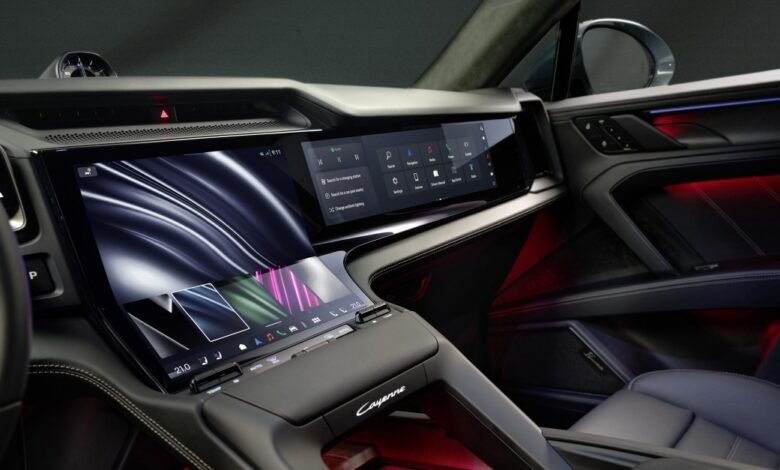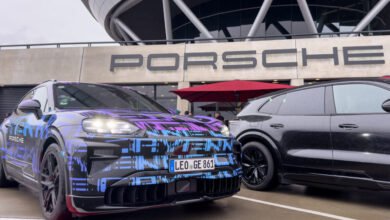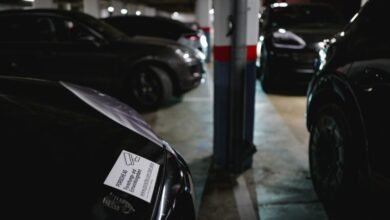Porsche’s Curved Screen Defines the Electric Cayenne

▼ Summary
– The Porsche Cayenne Electric features a unique curved OLED “Flow Display” that is the largest and most distinctive screen ever in a Porsche, running on a new operating system.
– Porsche’s new interior design combines Cayenne characteristics with digital interaction features, aiming for an innovative and harmonious overall package.
– The Cayenne Electric includes multiple screens: a 14.25-inch instrument cluster, heads-up display, and optional 14.9-inch passenger screen for streaming and apps.
– Porsche emphasizes driver engagement with an AI-powered voice assistant that understands complex commands and retains physical buttons for key functions like HVAC and volume.
– The interior redesign is part of Porsche’s strategy to compete with high-tech Chinese EVs and adapt to trends like immersive media and anticipated autonomous driving.
While the official unveiling of the Porsche Cayenne Electric is scheduled for later this year, the automaker has provided an exciting preview of its interior. A standout feature is the innovative curved OLED display, a design element that appears to be unprecedented in today’s automotive market. This screen, officially named the Flow Display, is installed vertically and curves toward the bottom, representing both the largest and most distinctive screen Porsche has ever integrated into a vehicle. It will operate on a completely new operating system, designed by Porsche to create a harmonious and flowing digital environment throughout the cabin.
Markus Auerbach, the director of interior design at Style Porsche, explained the design philosophy. He stated their objective was to merge the core characteristics of the Cayenne with newly developed display surfaces and the features of the new “Porsche Digital Interaction” system. The goal was to create a cohesive package that is innovative, forward-thinking, and meticulously detailed. While Porsche has not released the exact dimensions of the curved screen, likely due to the complexity of measuring its bend, reports suggest it spans nearly 42 inches. The new Cayenne’s cabin will also include a 14.25-inch digital instrument cluster, a heads-up display, and an optional 14.9-inch screen for the passenger to control video streaming and apps.
This development aligns with promises made by Porsche’s leadership. As early as 2023, Oliver Blume, Chair of the Executive Board of Porsche AG and CEO of the Volkswagen Group, pledged a “completely new experience” for the interiors of their new electric vehicles. The Cayenne Electric is the realization of that promise, signaling a significant reinvention of the cabin environment. This ambitious move is strategically important for Porsche. Although the brand saw an overall sales dip in the first half of the year, its all-new Macan crossover EV has been a success. Furthermore, sales of its fully electric and plug-in hybrid vehicles have surged, increasing by 14.5 percent compared to the same period last year, even as sales of its gasoline models have declined.
The introduction of the Flow Display could provide a significant advantage for the Cayenne Electric when it launches. However, it also presents a potential challenge in a market where some consumers are experiencing screen fatigue. Many car shoppers are reportedly growing tired of the minimalist, screen-heavy interiors popularized by Tesla and are expressing a desire for more physical buttons and tactile controls. Porsche asserts that the new Cayenne is designed with driver engagement in mind. It features a new AI-powered voice assistant capable of understanding complex commands and spontaneous follow-up questions without needing a repeated wake word. This system controls climate settings, seat heating, ambient lighting, and can recognize addresses and traffic information. The cabin also retains physical controls for essential functions like HVAC, volume, and window defrosting.
A point of curiosity is how phone mirroring will function with this expansive curved display, especially with Porsche slated to receive Apple’s next-generation CarPlay Ultra. The current version of CarPlay is shown to work on the Flow Display, but the integration of its more deeply embedded successor remains to be seen. Porsche’s interior overhaul is part of a broader trend among premium German automakers like Mercedes-Benz and BMW, who are reinventing their cabins to better compete with the influx of high-tech electric vehicles from Chinese manufacturers. Other entrants, such as the Sony-Honda joint venture Afeela, are centering their marketing on media, streaming, and gaming, anticipating a future where autonomous driving reduces the need for a driver’s constant attention to the road.
(Source: The Verge)


